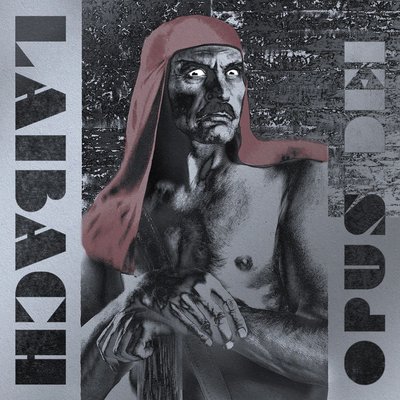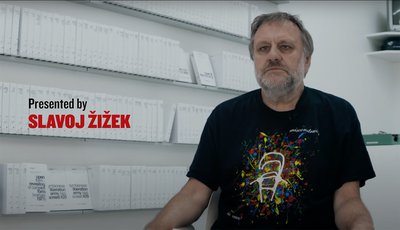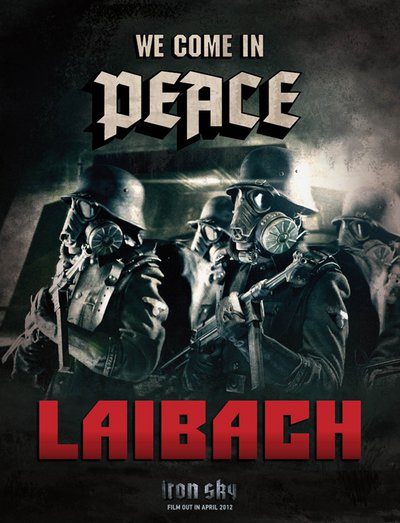"Laibach itself does not function as an answer but a question"
Superego is the obscene "nightly" law that necessarily redoubles and accompanies, as its shadow, the "public" Law. This inherent and constitutive splitting in the Law is the subject of Rob Reiner's film A Few Good Men, the court- martial drama about two marines accused of murdering one of their fellow soldiers. The military prosecutor claims that the two marines' act was a deliberate murder, whereas the defense succeeds in proving that the defendants just followed the so-called "Code Red," which authorizes the clandestine night-time beating of a fellow soldier who, in the opinion of his peers or of the superior officer, has broken the ethical code of the marines. The function of this "Code Red" is extremely interesting: it condones an act of transgression- illegal punishment of a fellow soldier- yet at the same time it reaffirms the cohesion of the group, i.e. it calls for an act of supreme identification with group values. Such a code must remain under the cover of night, unacknowledged, unutterable- in public everybody pretends to know nothing about it, or even actively denies its existence. It represents the "spirit of community" In its purest, exerting the strongest pressure on the individual to comply with its mandate of group identification. Yet, simultaneously, it violates the explicit rules of community life. (The plight of the two accused soldiers is that they are unable to grasp this exclusion of "Code Red" from the "Big Other," the domain of the public Law: They desperately ask themselves "What did we do wrong?" since they just followed the order of the superior officer.) Where does this splitting of the Law into the written public Law and its underside, the "unwritten," obscene secret code, come from? From the incomplete, "non-all" character of the public Law: explicit., public rules do not suffice, so they have to be supplemented by a clandestine, "unwritten" code aimed at those who, although they violate no public rules, maintain a kind of inner distance and do not truly identify with the "spirit of community."
The field of the law is thus split into Law qua "Ego-ldeal," i.e., a symbolic order which regulates social life and maintains social peace, and into its obscene, superegotistical inverse. As has been shown by numerous analyses from [Mikhail] Bakhtin onwards, periodic transgressions of the public law are inherent to the social order, they function as a condition of the latter's stability. (The mistake of Bakhtin -or, rather, of some of his followers-"- was to present an idealized image of these "transgressions," while passing in silence over lynching parties, etc., as the crucial form of the “carnevalesque suspense of social hierarchy.") What most deeply "holds together" a community is not so much identification with the Law that regulates the community's "normal" everyday circuit, but rather identification with a specific form of transgression of the Law, of the Law's suspension (in psychoanalytic terms, with a specific form of enjoyment). Let us return to those small town white communities in the American south of the twenties, where the reign of the official, public Law is accompanied by its shadowy double, the nightly terror of Ku Klux Klan, with its lynching of powerless blacks: a (white) man is easily forgiven minor infractions of the Law, especially when they can be justified by a "code of honor"; the community still recognizes him as "one of us." Yet he will be effectively excommunicated, perceived as "not one of us," the moment he disowns the specific form of transgression that pertains to this community-say, the moment he refuses to partake in the ritual lynching by the Klan, or even reports them to the Law (which, of course, does not want to hear about them since they exemplify its own hidden underside). The Nazi community relied on the same solidarity-in-guilt adduced by participation in a common transgression: it ostracized those who were not ready to assume the dark side of the idyllic Volksgemeinschaft, the night pogroms, the beatings of political opponents - in short, all that "everybody knew, yet did not want to speak about aloud."
"...the strategy of Laibach appears in a new light: it "frustrates" the system (the ruling ideology) precisely insofar as it is not its ironic imitation, but over-identification with it - by bringing to light the obscene superego underside of the system, over-identification suspends its efficiency."
It is against the background of this constitutive tension of the Law between public-written Law and superego that one should comprehend the extraordinary critical-ideological impact of the Neue Slowenische Kunst, especially of Laibach group. In the process of disintegration of socialism in Slovenia, they staged an aggressive inconsistent mixture of Stalinism, Nazism, and Blut und Boden ideology. The first reaction of the enlightened Leftist critics was to conceive of Laibach as the ironic imitation of totalitarian rituals; however, their support of Laibach was always accompanied by an uneasy feeling: "What if they really mean it? What if they truly identify with the totalitarian ritual?" -or, a more cunning version of it, transferring one's own doubt onto the other: "What if Laibach overestimates their public? What if the public takes seriously what Laibach mockingly imitates, so that Laibach actually strengthens what it purports to undermine?" This uneasy feeling is fed on the assumption that ironic distance is automatically a subversive attitude. What if, on the contrary, the dominant attitude of the contemporary "postideological" universe is precisely the cynical distance toward public values? What if this distance, far from posing any threat to the system, designates the supreme form of conformism, since the normal function of the system requires cynical distance? In this sense the strategy of Laibach appears in a new light: it "frustrates" the system (the ruling ideology) precisely insofar as it is not its ironic imitation, but over-identification with it - by bringing to light the obscene superego underside of the system, over-identification suspends its efficiency. (In order to clarify the way this baring, this public staging of the obscene fantasmatic kernel of an ideological edifice, suspends its normal functioning, let us recall a somehow homologous phenomenon in the sphere of individual experience: each of us has some private ritual, phrase [nicknames, etc.] or gesture, used only within the most intimate circle of closest friends or relatives; when these rituals are rendered public, their effect is necessarily one of extreme embarrassment and shame - one has a mind to sink into the earth.)
The ultimate expedient of Laibach is their deft manipulation of transference: their public (especially intellectuals) is obsessed with the "desire of the Other" -what is Laibach's actual position, are they truly totalitarians or not?- i.e., they address Laibach with a question and expect from them an answer, failing to notice that Laibach itself does not function as an answer but a question. By means of the elusive character of their desire, of the indecidability as to "where they actually stand," Laibach compels us to take up our position and decide upon our desire. Laibach here actually accomplishes the reversal that defines the end of psychoanalytical cure. At the outset of the cure is transference: the transferential relationship is put in force as soon as the analyst appears in the guise of the subject supposed to know - to know the truth about the analysand's desire. When, in the course of the psychoanalysis, the analysand complains that he doesn't know what he wants, all this moan and groan is addressed to the analyst, with the implicit supposition that the analyst does know it. In other words, i.e., insofar as the analyst stands for the Big Other, the analysand's illusion lies in reducing his ignorance about his desire to an "epistemological" incapacity: the truth about his desire already exists, it is registered somewhere in the Big Other, one has only to bring it to light and his desiring will run smoothly. The end of the psychoanalysis, the dissolution of transference, occurs when this "epistemological" incapacity shifts into "ontological" impossibility: the analysand has to experience how the Big Other also does not possess the truth about his desire, how his desire is without guarantee, groundless, authorized only in itself. In this precise sense, the dissolution of transference designates the moment when the arrow of the Question that the analysand pointed at the analyst turns back toward the analysand himself: first, the analysand's (hysterical) question addressed to the analyst supposed to possess the answer; then, the analysand is forced to acknowledge that the analyst himself is nothing but a big Question mark addressed to the analysand. Here one can specify Lacan's thesis that an analyst is authorized only by himself: an analysand becomes analyst upon assuming that his desire has no support in the Other, that the authorization of his desire can only come from himself. And insofar as this same reversal of the direction of the arrow defines drive, we could say (as Lacan does say) that what takes place 8tthe end of the psychoanalysis is the shift from desire to drive.






